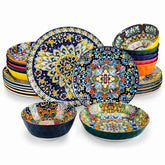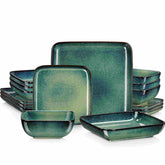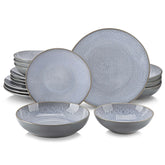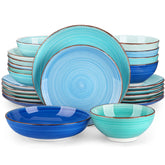Unveiling the Artistry of Reactive Glaze Stoneware in Culinary Excellence
When it comes to culinary artistry, the canvas is as important as the brush, and the choice of dinnerware can be a defining factor in the sensory journey of a meal. In the realm of pottery, reactive glaze stoneware emerges as a silent maestro, elevating the dining experience to a whole new level. In this exploration, we will peel back the layers of mystery surrounding this unique pottery, from its intriguing origins to its impact on culinary aesthetics. So, prepare to be enchanted as we delve into the world of reactive glaze stoneware.
Demystifying Reactive Glaze Stoneware
To truly appreciate reactive glaze stoneware, one must understand its roots. This captivating pottery has a storied history, dating back centuries to ancient civilizations like the Chinese Tang Dynasty. Its name, "reactive glaze," hints at the enchanting transformation it undergoes during firing. This process, rooted in the alchemy of minerals and clay, gives rise to the vibrant colors and intricate patterns that make reactive glaze dinnerware so alluring.
The magic lies in the unpredictability of the process. As various elements in the glaze react with the heat of the kiln, they dance and meld, producing a one-of-a-kind masterpiece every time. It's as if the potter relinquishes control to the kiln gods, allowing the pottery to emerge as a serendipitous work of art. This unpredictability, while challenging for potters, is precisely what makes reactive glaze stoneware so fascinating and unique.
The Spellbinding Characteristics
Reactive glaze stoneware's hallmark is its ever-changing appearance. Each piece is a visual symphony of colors and textures. From deep blues and earthy browns to fiery reds and sunlit yellows, the spectrum of colors is as broad as the artist's palette. This kaleidoscope of hues is a result of the mineral composition of the glaze and the kiln's firing process.
Imagine a dinner table adorned with reactive glaze stoneware plates, each one telling a different story. The way the glaze interacts with food, adding an artistic flourish to every dish, is nothing short of remarkable. Imagine serving a rustic tomato bisque in a bowl with a deep, marbled red interior that mirrors the richness of the soup. Or picture a salad on a plate adorned with a burst of blues and greens, a visual celebration of freshness.
Elevating Culinary Artistry
Reactive glaze stoneware isn't just a feast for the eyes; it's a catalyst for culinary artistry. Renowned chefs and home cooks alike have recognized its transformative power. Take, for example, a Michelin-starred chef who chooses reactive glaze stoneware for presenting his avant-garde creations. The dynamic colors and textures of the plates provide the perfect canvas for his edible masterpieces.
On the other end of the spectrum, consider the home cook who, with reactive glaze dinnerware sets, elevates everyday meals to memorable experiences. From a simple breakfast of poached eggs on a vibrant blue plate to a festive holiday dinner served on a tableau of reactive glaze stoneware, the possibilities are endless.
Nurturing and Preserving the Beauty
As enamoring as reactive glaze stoneware is, it demands care and attention to maintain its beauty. Fortunately, its durability and versatility make it a worthy investment. Caring for reactive glaze stoneware involves a few essential steps.
Firstly, cleaning should be done with a gentle touch. Handwashing is recommended to prevent chipping and prolong the glaze's life. Avoid harsh detergents and abrasive scrubbers, as they can mar the surface. Secondly, while reactive glaze stoneware is dishwasher safe, it's advisable to place pieces away from direct contact with other dishes to prevent scratching.
Microwaving is generally safe, but extreme temperature changes should be avoided to prevent thermal shock. Consider preheating the stoneware along with your oven or allowing it to come to room temperature before microwaving.
The Enthralling World of Collecting and Styling
Beyond its utility, reactive glaze stoneware possesses a captivating collectible value. Imagine owning a piece of history, a tangible link to the ancient traditions of pottery-making. Collectors worldwide covet these treasures, and their value only appreciates with time.
For those who seek to incorporate the beauty of reactive glaze stoneware into their homes, the possibilities are endless. It's not merely dinnerware; it's an extension of your personal style. Picture a rustic farmhouse kitchen adorned with an array of earth-toned reactive glaze stoneware, or a contemporary dining room where each piece serves as a conversation starter.
Where to Acquire Your Masterpiece
Acquiring reactive glaze stoneware requires discernment. While major retailers may offer mass-produced imitations, true connoisseurs seek out artisans and specialty shops. The authenticity of reactive glaze stoneware lies in the craftsmanship, and it's well worth the effort to find the real deal.
Consider the story of Sarah, an avid pottery enthusiast who stumbled upon a small pottery studio during her travels in the Southwest. There, she met a skilled artisan who crafted stunning reactive glaze stoneware pieces by hand. Each piece bore the mark of the artist's hand, and Sarah knew she had found a treasure. Her collection, now adorned with these unique pieces, is a testament to her appreciation for authenticity.
Conclusion
Reactive glaze stoneware isn't just pottery; it's artistry in every bite. Its rich history, captivating characteristics, and transformative potential in the culinary world make it a treasure worth exploring. Whether you're a collector, a chef, or simply someone who appreciates the beauty of a well-set table, reactive glaze stoneware offers a feast for the senses. So, embrace the magic, and let your culinary journey be as vibrant and dynamic as the reactive glaze itself.












